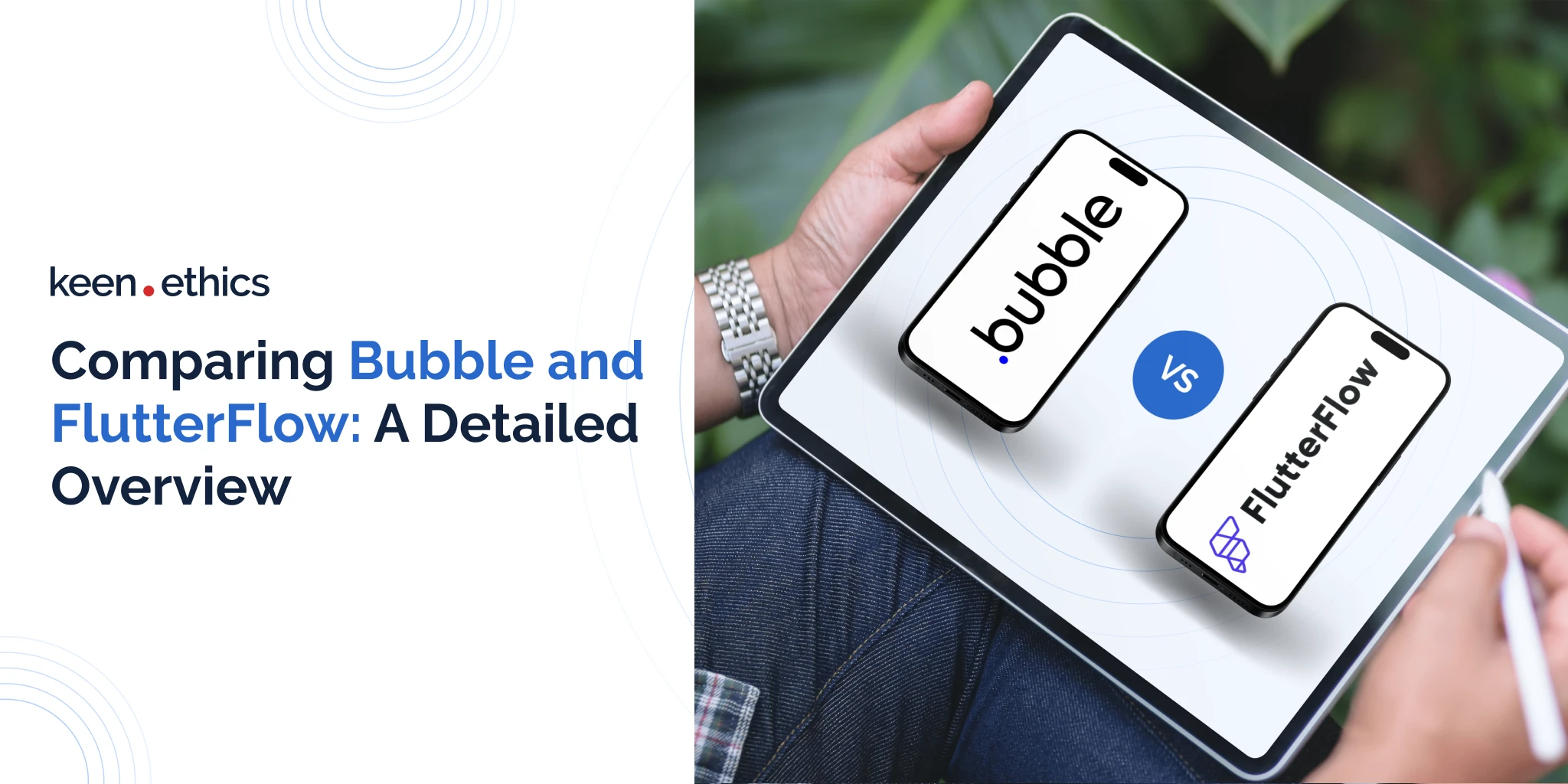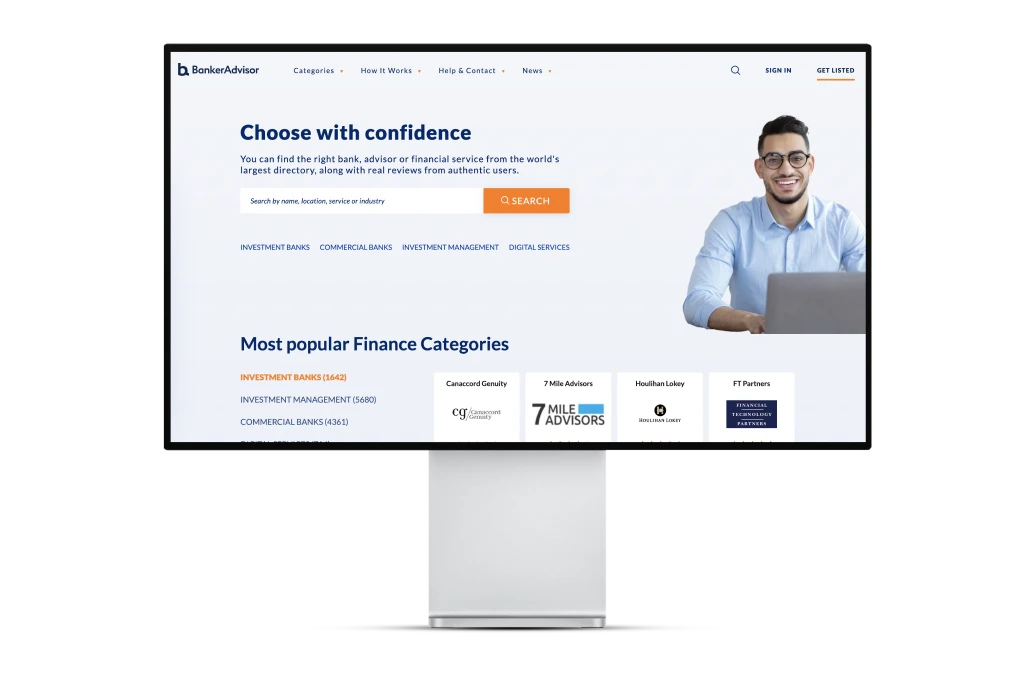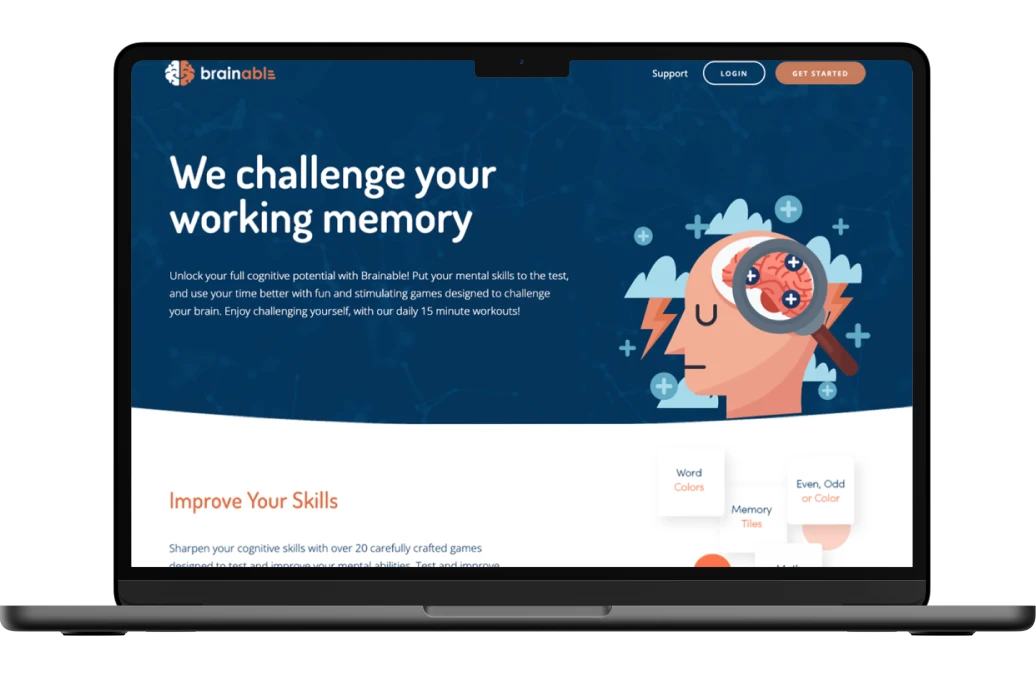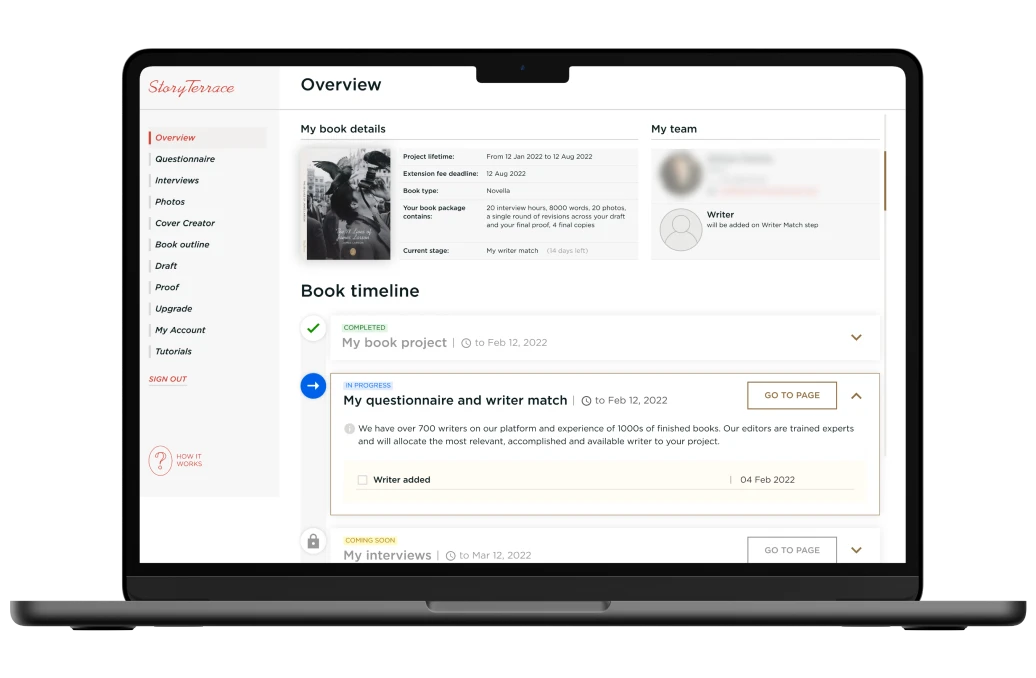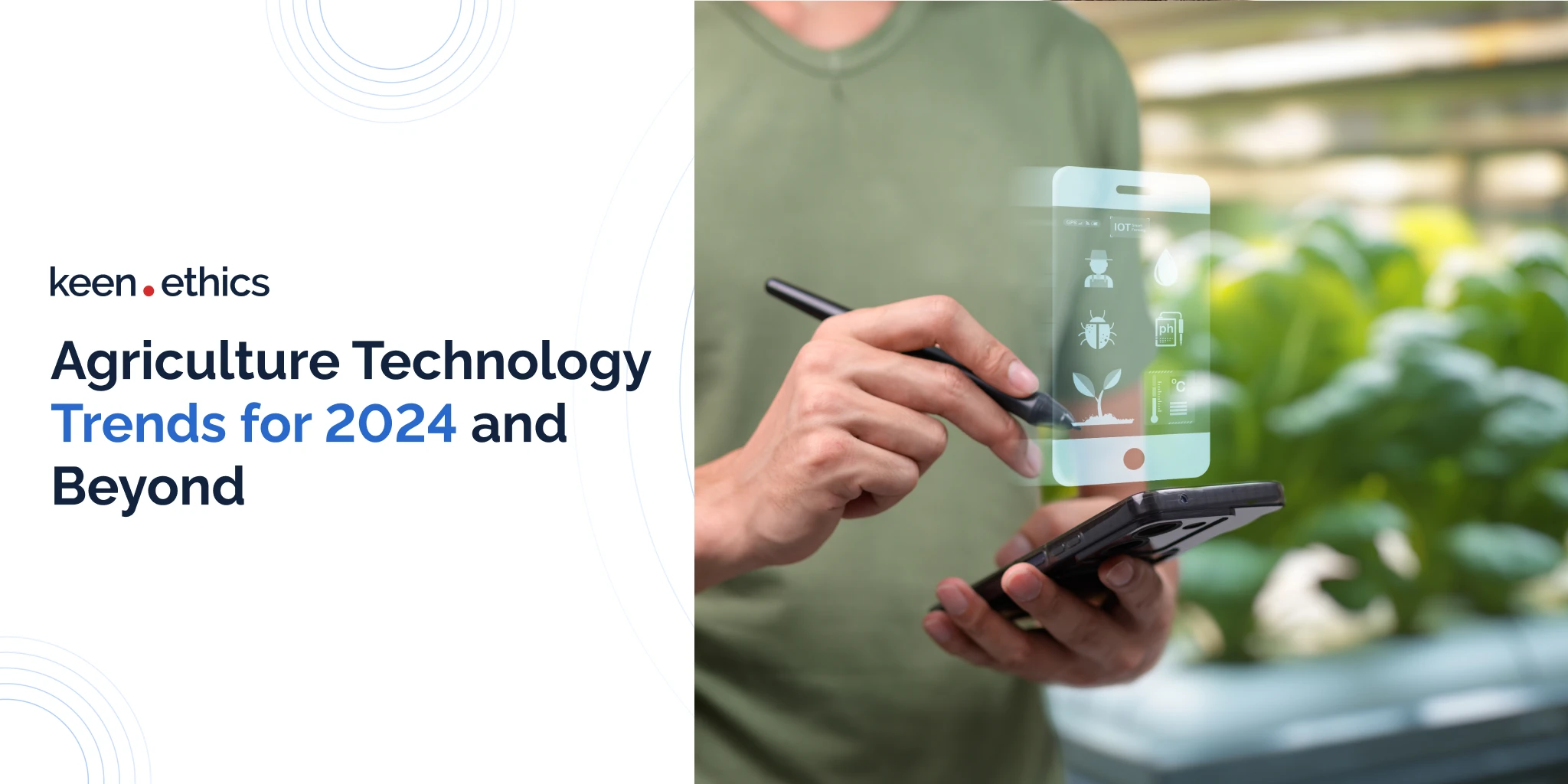Although we can’t totally predict the future use of low-code and no-code solutions, they present benefits we should assess and consider implementing in app development.
According to Forrester’s research, the low-code and digital process automation market reached $13.2 billion by the end of 2023 and is still expected to reach $30 billion by 2028.
The more digitalization evolves, the more businesses rely on software to streamline customer experiences. In this article, we’ll show how two popular platforms, Bubble and FlutterFlow, can help you meet customer demand. We’ll define their key differences and strengths and try to select the right tool for your project needs.
Understanding FlutterFlow
FlutterFlow is an open-source and low-code visual development platform designed to streamline the development process and make everyone work seamlessly. It offers a drag-and-drop interface to connect data sources and create Flutter apps without coding easily. It’s 10 times faster than traditional app development tools and accessible to diverse business users. FlutterFlow is built on Flutter, so if you need to extend the app functionality via coding, you can address Flutter developer for your purpose. The app created with FlutterFlow can easily migrate to Flutter. With FlutterFlow built-in templates, third-party services, and pre-built modules, you can easily develop quality business or complex applications without code.
Is FlutterFlow the perfect solution for your current or future app? We’ll find out in the next sections.
Understanding Bubble
Even without development or code expertise, you can build your own app that customers love. When you have an idea, there are no reasons not to make the app your business requires. So what is Bubble development, and why should you care?
Bubble is the world’s full-stack, no-code platform, allowing everyone to build full-fledged web apps without writing a single line of code. It’s not the perfect choice for creating a landing page or a website, but this is for you if you want to develop your full-stack version of some project (Trello, Instagram, Snapchat, or others). When logging into the platform, you can start from any template taken from a marketplace. It’s beneficial since you can preview its functionality directly on the website. Bubble is a visual programming language that gives you full control over your product. Its editing mode allows you to modify the content in a way that directly mirrors how the final product looks like. It resembles the principle of a PowerPoint presentation, where you get what you see. With Bubble, you get flexibility when using its built-in templates, plugins, and third-party integrated APIs.
Bubble vs FlutterFlow: Key Features and Differences
Personalization
Bubble’s user interface is more web-focused, while FlutterFlow’s is optimized for cross-platform mobile development.
Bubble has a flexible drag-and-drop editor where users can create their web apps from scratch. Users create an interface with responsible, intuitive design features, placing diverse elements from texts to buttons and adapting the layouts for different screen sizes of mobiles and desktops. Bubble offers customization of elements and workflows, data structures, and API integrations. Its marketplace offers users a wider range of customizable options and additional functionality.
FlutterFlow also has a drag-and-drop visual interface but is more practical for developing mobile and web apps using Goggle’s toolkit and Flutter. In some way, its interface resembles Flutter functionality, whereas its built-in widgets and templates align with Flutter’s Material Design. Generally, FlutterFlow allows users to make more consistent designs with less expertise and resources.
Collaboration Features
FlutterFlow and Bubble are worth using for teams working on the same project simultaneously. They incorporate multi-user collaboration with the mechanisms to control access and permissions to ensure the users have proper roles and responsibilities within the project. Version control in Bubble allows teams to manage different versions of the apps, which is highly useful when the team should track the changes, test new functionality, or turn back to the previous versions. If comparing the version control of the two platforms, Bubble is more complex. While Bubble provides detailed permission levels and control, FlutterFlow focuses on access sharing by offering user roles. Robust version control of FlutterFlow streamlines collaboration and minimizes loss of data.
The Programming Language
Compared to Bubble, FlutterFlow offers a better level of code customization. The benefit of FlutterFlow is that the platform is built on Flutter and offers a pub.dev library of usable code components, allowing the users to reuse the code. The prebuilt code packages can provide you with additional features. Let’s say you want to integrate schedule planning into your app. You can use exported Flutter code or find this package and integrate it from the pub.dev library. You shouldn’t create it from scratch. Bubble is a proprietary platform that doesn’t let you export code or migrate to other platforms. However, if you have some coding knowledge, you can integrate custom JavaScript, HTML, or CSS into your project. Using such code integration, you can add more complex interactions, custom styling, and third-party integration, which aren’t available via the editor.
AI Development Support
Developers can now build faster with AI assistance. Both platforms – Bubble and FlutterFlow – integrate AI to streamline code generation and suggestions. You can describe what type of page you need and how it should look, and an AI assistant will help you create a beautiful and personalized interface.
Core Platform Features
Bubble offers a highly flexible drag-and-drop interface, allowing users to freely arrange elements and customize them to the users’ needs. Everything can be adaptable to diverse screen sizes. Since secure data management is critical for any app, the users shouldn’t spend time selecting external database services. Bubble comes with integrated database management tools that enable users to control and modify databases within the platform. Automation in Bubble is robust, letting users automate many actions and processes. Connection with external services is also another beneficial solution. The users can integrate API and extend the functionality of their app thanks to the plugin marketplace.
The best feature of FlutterFlow is that the platform is based on Flutter, which allows you to develop with a single codebase. It ensures you get consistency in design and performance across diverse platforms. Changes made by one user are seen by others since the platform supports vast real-time collaboration features. Prebuilt templates and widgets allow you to adhere to Flutter design principles and design visually attractive interfaces without creating them from scratch. With FlutterFlow, you save time and resources for code integration while adding custom Dart code and using Firebase for backend management.
Built-In Templates
Developing an app from scratch is usually the best way to meet your needs. However, using the built-in templates, whether in Bubble or Flutterflow, is always proper. As for Bubble, it has a lot of no-code templates for many use cases, from e-commerce and social networking to healthcare, which you can customize to your needs. As for FlutterFlow, although the platform helps you clone the prebuilt apps, you still need to invest your time adjusting modifications. It will help you meet your needs. Despite this, the templates of Bubble and FlutterFlow serve as a good starting point for you to develop.
SEO Capabilities
The benefit of Bubble is that the platform has some SEO tools. You can customize SEO titles and descriptions within the Bubble and set the keywords to your domain. Bubble also handles website URLs and connects to popular SEO services to show your product to the right users.
Since FlutterFlow is more designed for mobile app development, it offers fewer SEO capabilities. You can customize some basic settings, including meta tags, to show what your app is about. If you choose FlutterFlow for your project, when addressing us, our specialists can offer you excellent SEO tools that you can integrate into your app to make it more advanced within search engines.
Scalability
The more users the app gets, the more data it needs to handle. This is where scalability and performance come in. Within Bubble, you get robust features to scale your app. By adding custom code and building unique features, you can handle increased traffic and efficiently manage user-growing demands.
FlutterFlow is also a practical platform for scalable apps, allowing you to support high user volumes without impacting performance. When integrating your app with Firebase (some features for extra cost), you can seamlessly scale the backend infrastructure of your app. For advanced customization, you can use Flutter with its package of features.
Learning Curve
Although both platforms are user-friendly and offer high customization and flexibility, their learning curves differ. Before developing on Bubble, its community, documentation, and open-source tools can help, but you will still need to understand how the platform works.
Similarly, while FlutterFlow is better at cloning apps and allowing you to use pre-made components and pages, customizing your app with all those templates still requires time. You should learn the development process in FlutterFlow and how to modify templates to best meet your preferences and goals.
How much time it takes to learn Bubble or FlutterFlow? Since everyone learns differently, the time needed to understand the two platforms may differ. For this reason, providing some subjective hours for understanding the platforms’ learning curve isn’t relevant. The factors influencing your learning speed are the time you can commit, the budget you can invest, and the type of project you will develop.
Economical Side
Hiring development services isn’t cheap; learning to code yourself requires time and resources. You can start developing without extensive coding knowledge if you have an idea for a digital project. Both platforms make your path to software development faster and more cost-efficient.
Community
From Keenethics’ experience, the communities of both platforms are active and provide users with extensive resources. From basic apps to complex ones, users can find support to customize their apps according to their needs. However, while the FlutterFlow community is smaller, Bubble has an active and supportive one.
Users of FlutterFlow can turn to community forums, join the Discord group, and hire consultants for assistance. The FlutterFlow community is collaborative and provides many learning resources, from guides to reference materials for diverse skill levels. Bubble also has a good community offering a range of documentation and tutorials for beginner and advanced users. Even more, the Bubble Academy is a resource where users can find all the educational content for starting development.
Bubble vs. FlutterFlow: Pros and Cons
Bubble’s Pros and Cons Compared to FlutterFlow
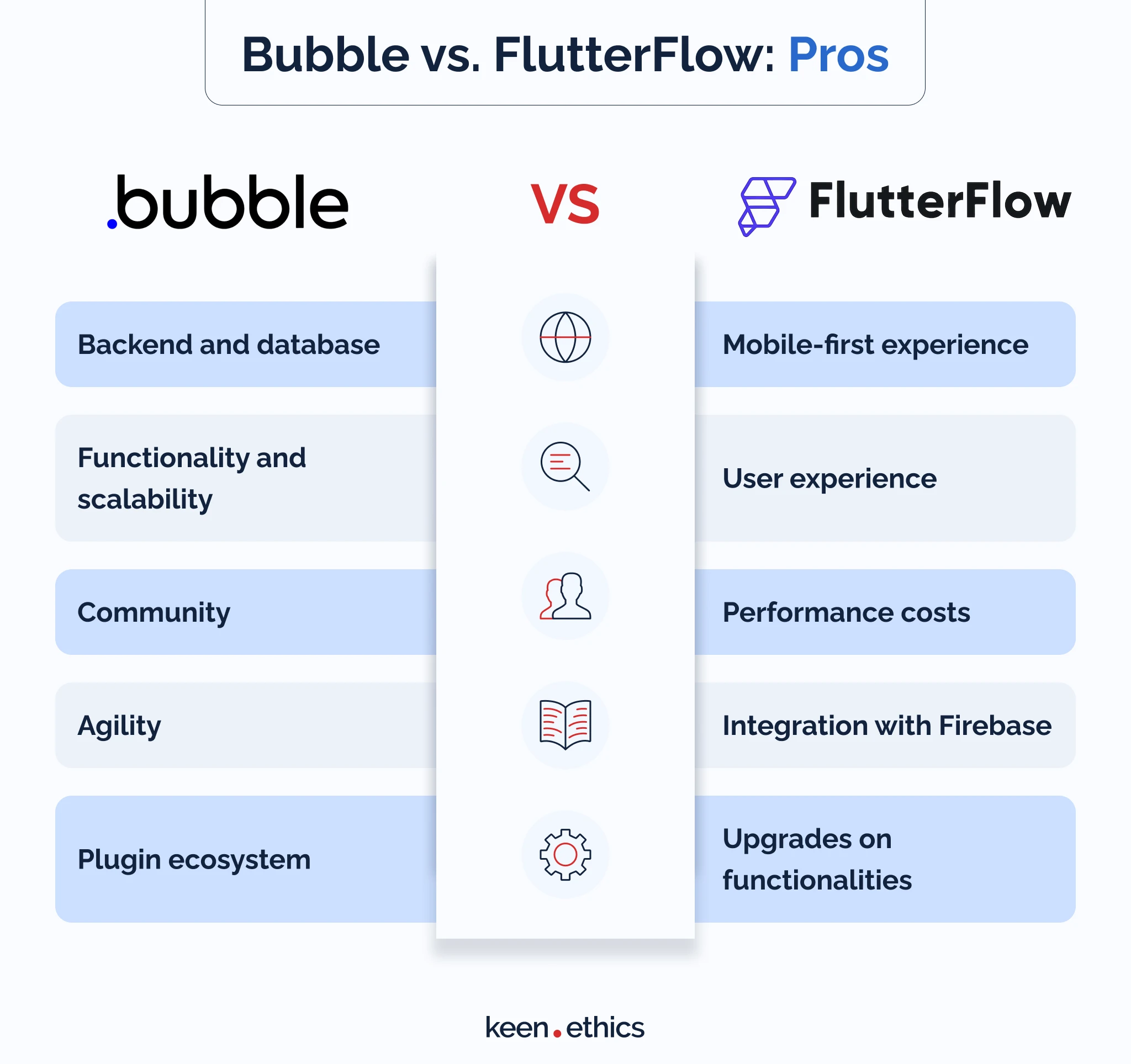
Let’s view in detail the benefits and drawbacks of Bubble.
- Backend and database
When considering Bubble’s benefits over FlutterFlow, we would define its built-in backend and database as the prime feature that stands it apart. Bubble incorporates a built-in database for managing complex workflows and logic directly within the platform. Accordingly, you can create, store, and manipulate data while simultaneously automating the processes.
- Functionality and scalability
Bubble offers functionality for different apps and websites. You can use a drag-and-drop interface, database management, workflow, and automation. What’s more, Bubble’s architecture allows you to scale your app as your business needs grow. As a result, you shouldn’t worry that user traffic and data demands won’t align. Other features, including secure user hierarchy, integration with third-party tools and services, and full customization with CSS and JavaScript allow you to benefit more from the platform.
- Community
Bubble’s community unites users and developers worldwide to move development to a new stage. You can ask for consulting if you require help with learning resources or development cycles.
- Agility
Bubble is a platform that offers a robust foundation for development. All you need to do is drag and drop built-in modules and create core functionality according to your app ideas and vision. In turn, Bubble allows you to test the app before its release, which lowers development costs for testing, bug fixing, and maintenance in the long run.
- Plugin ecosystem
Bubble has a large marketplace of built-in plugins, which you can use to extend functionality and make advanced features without extensive coding expertise.
To better understand how this or other platform wins, reviewing its drawbacks is reasonable, too.
Cons of Bubble over FlutterFlow
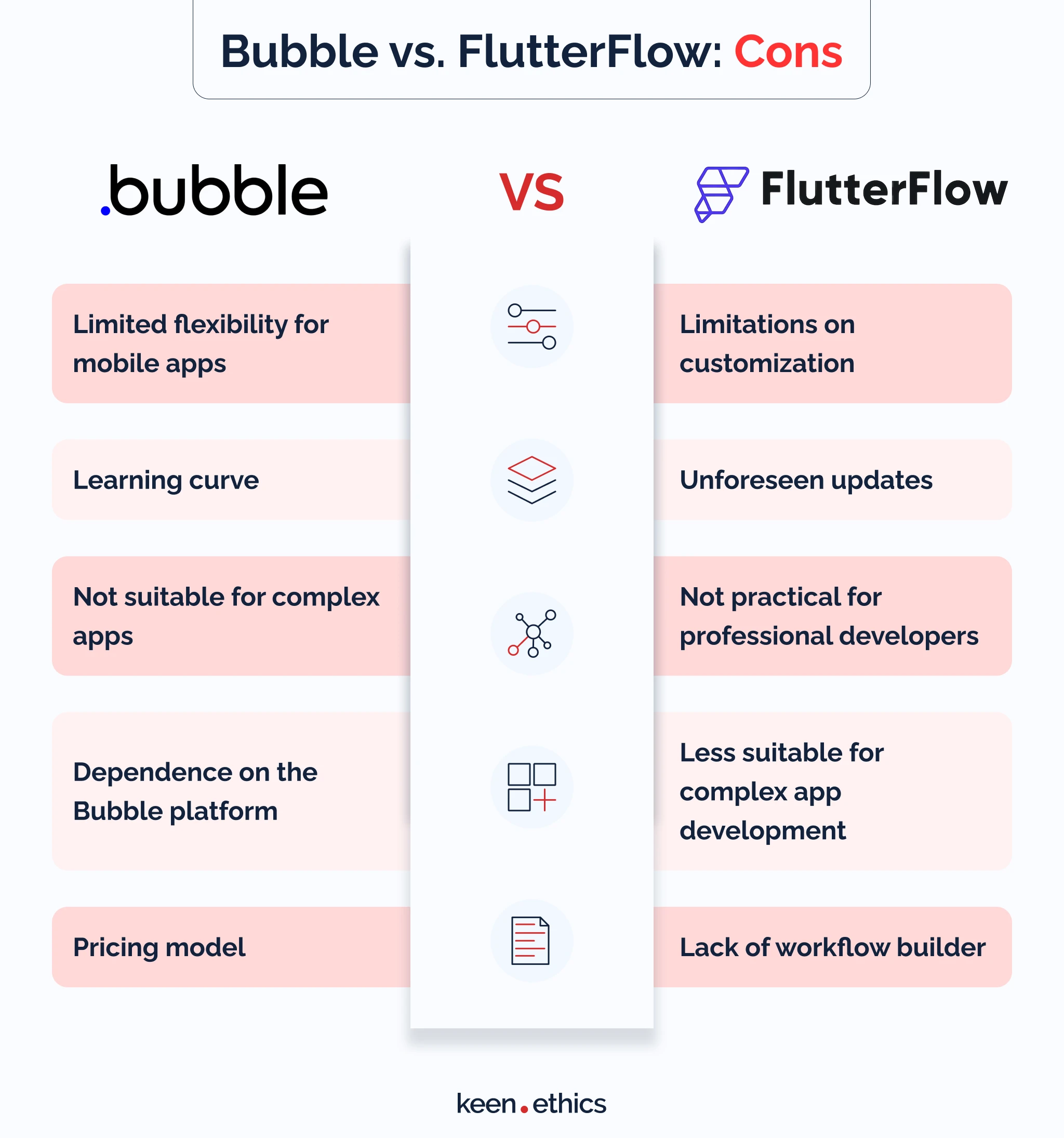
- Limited flexibility for mobile apps
As we mentioned earlier, Bubble is more designed for web apps and offers less flexibility in design for developing responsive mobile applications. In this scenario, it’s better to choose FlutterFlow.
- Learning curve
To learn how the platform functions, you should first learn how to work with the visual editor, workflow setup, and database management with its settings and tools. At first glance, the logic and workflow setup can be complex, so it’s critical to understand how to manage actions seamlessly to build functional apps.
- Not suitable for complex apps
App performance and user experience must be error-free, so creating an intuitive design is critical to properly meeting users’ demands. Consider that in the case of Bubble, you can’t fully meet the extensive design needs and may integrate other extensions into your app.
- Dependence on the Bubble platform
The users who use Bubble for development depend on its tech stack. The apps they build on Bubble rely on infrastructure and can be hosted on the Bubble platform. However, we can view such dependence from both the positive and negative sides. On the one hand, Bubble provides various tools and services for deploying and maintaining apps. On the other hand, if you want to customize, scale, and integrate apps with other systems, your tech stack may provide you with limited options.
- Pricing model
Bubble charges users based on the number of active users per month. While the price is quite manageable for small—to medium-sized businesses, growing businesses may find the platform expensive.
FlutterFlow’s Pros and Cons Compared to Bubble
Let’s define the beneficial features you may prioritize when choosing FlutterFlow over Bubble.
- Mobile-first experience
FlutterFlow focuses on developing optimized mobile apps with a seamless user experience across diverse devices and screen sizes. Apps built on FlutterFlow are available for mobile devices, Android, iOS, and the web. The cross-platform consistency of FlutterFlow ensures you will spend less time working with the same codebase.
- User experience
Flutter helps create high-performing compiled mobile apps. The principle is the same, considering FlutterFlow is built on Flutter. Prebuilt widgets allow users to customize mobile app interfaces. However, if we focus on the design for web app functionality, Bubble is a better choice. Its drag-and-drop editor helps create more complex web interfaces without coding.
- Performance costs
Apps you build with low-code platforms can sometimes have performance problems compared to those you make with conventional software development techniques and coded solutions. The first reason is that the low-code platform provides a more generalized code that cannot be optimized for your needs. Secondly, your low-code built app can include additional unnecessary code for every use case. Finally, since low-code apps operate on shared infrastructure where other apps share the same resources, it can increase heavy load and lower optimization. However, low-coded solutions are also efficient and can function successfully on the market if these apps are tested thoroughly and ensure they meet performance standards.
- Integration with Firebase
Firebase helps you extend backend functionalities, even if you want to add user authentication and databases. FlutterFlow has built-in support for Firebase authentication, database, and storage. You only need to set up a Firebase project and connect it to your FlutterFlow project. Also, you can configure different APIs and services and add custom Flutter/Dart code within FlutterFlow if you need more advanced custom functions.
- Upgrades on functionalities
FlutterFlow can boast the capacity to create basic versions of mobile apps and web pages quickly. The functionality of FlutterFlow gets regular updates. Every week, new valuable features come, which ensure the tool has a long-term perspective for its use in the web development market. While FlutterFlow is developing, it still makes some bugs and offers less robust functionality. However, there are regular updates that solve the most common bugs and limitations of FlutterFlow. Using FlutterFlow, the developers can create apps, get user feedback, and make product decisions. It offers fast development speed for non-complex logic apps, which is highly beneficial.
Cons of FlutterFlow over Bubble
- Limitations on customization
While FlutterFlow includes various pre-made components, customizing them for complex app designs can be restricted. Developers can incorporate custom code to achieve unique designs, working within an external development environment. However, this approach can be more challenging, especially if you continue using FlutterFlow’s features or collaborate within the platform afterward.
- Unforeseen updates
FlutterFlow frequently introduces updates that can sometimes be unpredictable, potentially causing development issues even if no changes were made to the project. This is because updates might introduce new features, modify existing ones, or fix bugs, which can disrupt existing workflows or cause compatibility issues. While regular updates are effective in numerous ways, to mitigate the risks, it’s proper to conduct additional quality assurance work to detect areas where the updates may impact the app’s work.
- Not practical for professional developers
Since professional developers used to have more control over the app development process than just using drag-and-drop functionality, FlutterFlow might not be the best match for them. Moreover, when the needs scale and the developer wants to expand the app’s functionality, they may scale the app only by accessing boilerplate code.
- Less suitable for complex app development
Using FlutterFlow, you don’t have access to boilerplate functions and utilities. FlutterFlow abstracts much of the development process to keep it simple and visually driven. In some way, the lack of access to boilerplate code slows down the development. Although it may be challenging to implement customized and complex features, FlutterFlow enables you to create impressive apps. It’s not necessarily bad for app development, but it can be limiting depending on your app’s complexity.
- Lack of workflow builder
Using FlutterFlow, you don’t have the workflow builder that you can use to add complex logic to FlutterFlow templates. You may struggle to develop apps with detailed user flows, automation, and decision-making. To handle more advanced logic, you may need to write custom code that requires more tech expertise.
Bubble or FlutterFlow: Who Is the Winner?
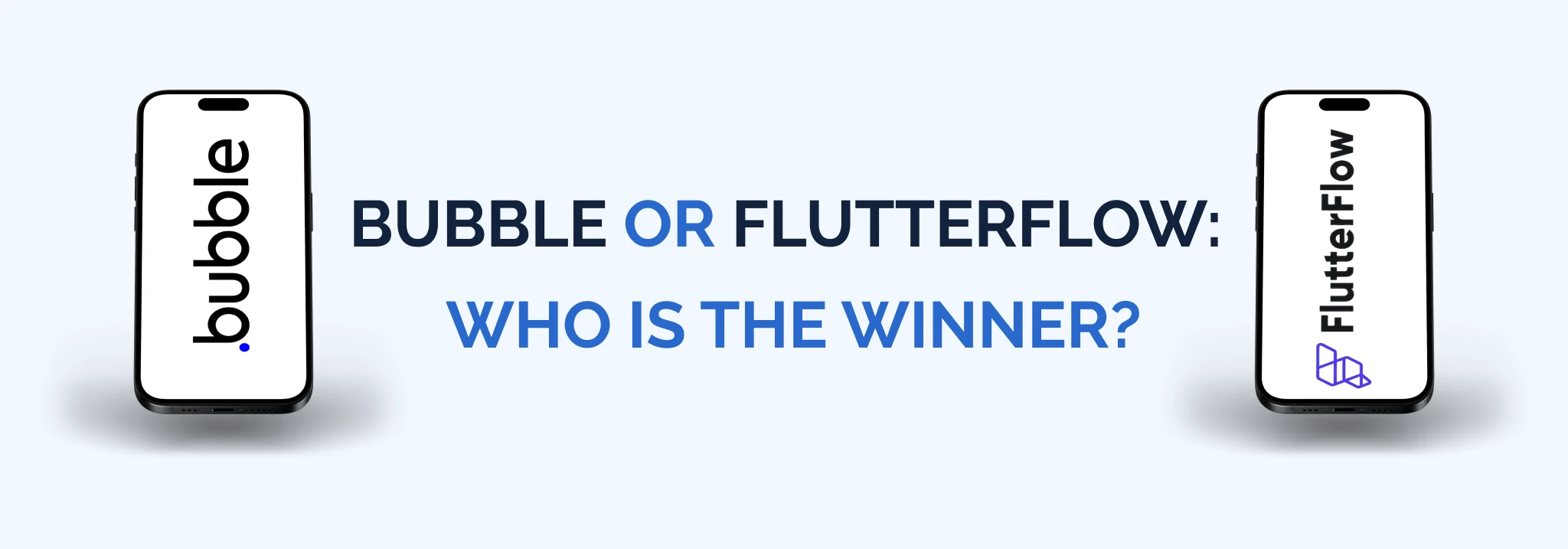
FlutterFlow vs Bubble: for a nontech person, it’s often a question of what to choose when both tools have unique benefits. FlutterFlow and Bubble are two great attractive options for product development. However, which is the best depends on your needs and preferences for the functionality of your app. First, select the goals you want to achieve, analyze which functionality can help you, and review which platform can offer you the proper benefits. After examining all the features, benefits, and distinguishing points of FlutterFlow and Bubble, decide what type of product you want to develop. If your choice is a native and responsive mobile app – select FlutterFlow; if your choice is a web app with a vast range of data to manage – Bubble is a perfect match.
Regarding pricing, both models are cost-efficient, each offering its flexible plans. However, when choosing, ensure it meets your needs and budget. Then, think about the perspective growth of your solution. If you plan to scale it in the long run, Bubble offers a broad range of plugins and higher flexibility. Active community and open-source resources provided by the platform are also important since they are helpful for development.
Remember that professional guidance is essential when you have a clear project vision but are still uncertain about your choice. Keenethics, with 9 years of experience in no-code development service, can provide the clarity and support you need. By focusing on your goals and needs, we’ll ensure you make a decision that aligns with your vision and sets you up for success.
Keenethics’ Guidance in Your Non-Code Projects
Keenethics, with 9 years of experience in the development market, has proven its expertise in no-code and low-code development. Whether you are a startup or the entrepreneur of a large business, we can help you build stable mobile apps for diverse platforms and devices.
We follow the market and keep up with technology tendencies to propose to our clients opportunities that bring them competitive perspectives. By ensuring each client project is unique, we offer personalized guidance on the right tech stack and strategies to align with your end goals. In a rapidly evolving tech market, partnering with the right web team is important. Check our portfolio or schedule a free consultation to start your project successfully.
FAQ
How do Bubble and FlutterFlow compare in terms of development costs?
FlutterFlow and Bubble offer free trials for you to start. An average monthly Bubble plan ranges from $29 for the starter version to $349 for the enterprise version. FlutterFlow price ranges from $30-70 and is designed to adapt to the needs of diverse users – startups, professional developers, or large companies. In the case of FlutterFlow, you pay separately for your database, which is a cheaper solution, especially if you plan to scale your app. Bubble and FlutterFlow offer several pricing plans, from basic to premium versions, with more advanced functionality. The cost of app development with Bubble and FlutterFlow depends on the complexity of the features you want to see on your platform.
How do the features and capabilities of FlutterFlow and Bubble differ?
When comparing Bubble and FlutterFlow, Bubble is used to be a versatile solution in web app development with its drag-and-drop interface. This tool primarily focuses on web apps, providing you with a quality visual editor to design complex workflows without code writing. Its wide range of plugins and integrations allows you to make customizable web-based solutions. In contrast, FlutterFlow is known for its capacity to create cross-platform mobile apps. Using FlutterFlow, you can seamlessly design user interfaces working across diverse devices. In general, if you want to build a web app with complex backend requirements, Bubble is a better choice. Conversely, FlutterFlow would be better if you focus on mobile app development and require cross-platform functionality.
What are the main constraints of using FlutterFlow for the application development process?
Compared to traditional coding, FlutterFlow has some limitations. While it offers many pre-built templates and components, you can face restricted options when customizing your app. If you wish to implement highly specific design elements or complex functionality, you need to consider the integration of some other tech solutions. Also, while FlutterFlow is quite user-friendly, it takes time for non-developers to learn how the platform functions. Since FlutterFlow is built on Flutter, any changes in the Flutter framework can impact your FlutterFlow project. All in all, these limitations don’t necessarily lower the strength of FlutterFlow, but you need to view them when considering the requirements and complexity of your app.
Which is the better platform for building mobile apps: Bubble or FlutterFlow?
If we are talking about mobile apps, FlutterFlow offers a better experience than Bubble. Its distinguishing features include rich UI components, cross-platform support, native-like performance, and Firebase integration, making the platform a high-quality choice.
How do Bubble and FlutterFlow perform when handling apps of varying sizes and complexities?
While Bubble is preferred for web apps and FlutterFlow is more used for mobile-optimized solutions, their performance metrics largely depend on the size and complexity of your solution. If your app doesn’t involve highly complex workflows or large built-in databases, Bubble’s performance is smooth. However, FlutterFlow is more suited for complex mobile apps due to its Flutter management capabilities.
In terms of scalability for large apps, Bubble often requires careful optimization of workflows, database queries, and plugins to maintain optimal performance. On the contrary, since FlutterFlow can compile into native code, it’s far easier to handle high user loads and complex data-intensive tasks. FlutterFlow generally offers better performance metrics for mobile apps of different sizes and complexities due to its native compilation and optimization for mobile environments. While being strong in web app development, Bubble may struggle with performance when adapting to mobile app needs, especially as complexity grows.
Schedule a free call with Keenethics to learn more about the innovative perspectives which Bubble, Flutter, or other technological solutions can bring to your business.

